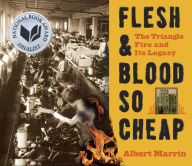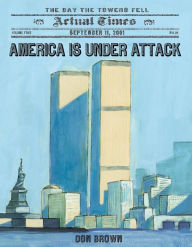We've Got a Job: The 1963 Birmingham Children's March
Paperback
$13.95
- ISBN-13: 9781561458448
- Publisher: Peachtree Publishers, Ltd.
- Publication date: 02/01/2015
- Pages: 180
- Sales rank: 44,376
- Product dimensions: 8.80(w) x 9.30(h) x 0.70(d)
- Age Range: 12 - 15 Years
Eligible for FREE SHIPPING details
Choose Expedited Delivery at checkout for delivery by. Thursday, November 21
13.95
In Stock
We've Got a Job tells the little-known story of the 4,000 black elementary-, middle-, and high school students who voluntarily went to jail in Birmingham, Alabama, between May 2 and May 11, 1963. Fulfilling Mahatma Gandhi's and Dr. Martin Luther King, Jr.'s precept to "fill the jails," they succeeded—where adults had failed—in desegregating one of the most racially violent cities in America. Focusing on four of the original participants who have participated in extensive interviews, We've Got a Job recounts the astonishing events before, during, and after the Children's March.
Customers Who Bought This Item Also Bought
-
- Courage Has No Color: The True…
- by Tanya Lee Stone
-
- Freedom's Children: Young…
- by Ellen Levine
-
- As Good as Anybody
- by Richard MichelsonRaul Colon
-
- The Port Chicago 50: Disaster,…
- by Steve SheinkinChristine Barcellona
-
- Child of the Civil Rights…
- by Paula Young SheltonRaul Colon
-
- What Color Is My World?: The…
- by Kareem Abdul-JabbarRaymond ObstfeldBen BoosA.G. Ford
-
- Heart and Soul: The Story of…
- by Kadir NelsonKadir Nelson
-
- Freedom in Congo Square
- by R. Gregory Christie
-
- Flesh and Blood So Cheap: The…
- by Albert Marrin
-
- Freedom Walkers: The Story of…
- by Russell Freedman
-
- Martin & Mahalia: His…
- by Brian PinkneyAndrea Davis Pinkney
-
- Sit-In: How Four Friends Stood…
- by Andrea Davis PinkneyBrian Pinkney
-
- A Wreath for Emmett Till
- by Philippe LardyMarilyn Nelson
-
- America Is Under Attack:…
- by Don Brown
-
- Brick by Brick
- by Charles R., Jr. Smith Jr.Floyd Cooper
Recently Viewed
Publishers Weekly
This chronicle of a pivotal chapter of the civil rights movement weaves together the stories of four black children in Birmingham, Ala., who were among some 4,000 who boycotted school to participate in a march to protest segregation. Before recounting that event, during which almost 2,500 young people were arrested and jailed, first-time author Levinson opens with intimate profiles of the four spotlighted children (drawn from interviews she conducted with each of them), along with descriptions of Birmingham’s racist laws, corrupt politicians, antiblack sentiment—and activists’ efforts to fight all of the above. Readers also get an up-close view of such leaders as Rev. Fred Shuttlesworth, who founded the Alabama Christian Movement for Human Rights; Rev. Martin Luther King Jr., who advocated a nonviolent response; and James Bevel, a preacher who rallied the city’s children and teens. Yet the most compelling component is Levinson’s dramatic re-creation of the courageous children’s crusade and the change it helped bring about in the face of widespread prejudice and brutality. Powerful period photos and topical sidebars heighten the story’s impact. Ages 10–up. Agent: Erin Murphy, Erin Murphy Literary Agency. (Feb.)Children's Literature - Marilyn Courtot
If you have ever doubted that one person can make a difference then Levinson's book will certainly convince readers that they and others who are like-minded can make changes in the world. It really is sad that so little of the details of American history are taught in our schools. Yes, we hear about the Civil Rights Movement and the National Voting Rights Act and sometimes about significant Supreme Court cases such as Plessy versus Ferguson, but it is all so abstract. Levinson has succeeded in bringing the tumultuous times in Birmingham and the 1963 Birmingham Children's March down to a personal level that is truly riveting. What really happened to the four students featured in the book and thousands of other children was really unknown by this reviewer. Yes, I had heard of the marches, the brutality of the police force and the bombing at the Sixteenth Baptist Church and other deaths, but it was always a bit abstract. Reading this book—you are there, you feel the frustration of the leaders like Fred Shuttleworth and Martin Luther King Jr. You realize that there were struggles within the black community as to the best way to achieve their goal of freedom and full integration and the fear and ambivalence of moderate whites. It also shows how many other black leaders were involved and how important their roles were in sustaining the movement. Could I as a teenager have ever done what Audrey, Wash, James, and Arnetta did? I am not so sure that I would have been brave enough. This is a book that every student should read. It is also a book that should make African Americas of today realize what it took to achieve what they take for granted—freedom to go to integrated public schools, enter any public place or conveyance, work anywhere, and live anywhere they choose. These freedoms were won at a great price as the details of these struggles in Birmingham reveal and they should not be squandered. The photographs, layout with subheadings, and call outs to emphasize a point or put things in perspective all help make this rich text eminently readable. For those undertaking research there are extensive source notes, a bibliography and a very detailed index. A must have for a school or classroom library. Reviewer: Marilyn CourtotKirkus Reviews
Triumph and tragedy in 1963 "Bombingham," as children and teens pick up the flagging Civil Rights movement and give it a swift kick in the pants. Levinson builds her dramatic account around the experiences of four young arrestees—including a 9-year-old, two teenage activists trained in nonviolent methods and a high-school dropout who was anything but nonviolent. She opens by mapping out the segregated society of Birmingham and the internal conflicts and low levels of adult participation that threatened to bring the planned jail-filling marches dubbed "Project C" (for "confrontation"), and by extension the entire civil-rights campaign in the South, to a standstill. Until, that is, a mass exodus from the city's black high schools (plainly motivated, at least at first, almost as much by the chance to get out of school as by any social cause) at the beginning of May put thousands of young people on the streets and in the way of police dogs, fire hoses and other abuses before a national audience. The author takes her inspiring tale of courage in the face of both irrational racial hatred and adult foot-dragging (on both sides) through the ensuing riots and the electrifying September bombing of the Sixteenth Street Baptist Church, then brings later lives of her central participants up to date. A moving record of young people rising at a pivotal historical moment, based on original interviews and archival research as well as published sources. (photos, timeline, endnotes, multimedia resource lists) (Nonfiction. 11-15)














